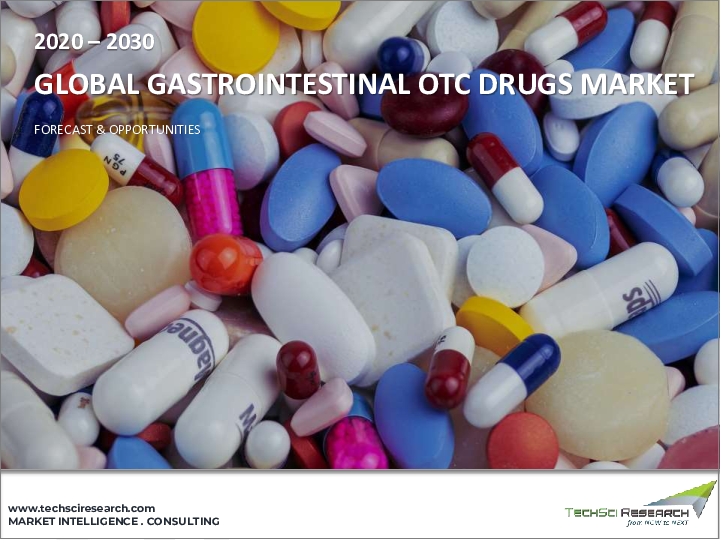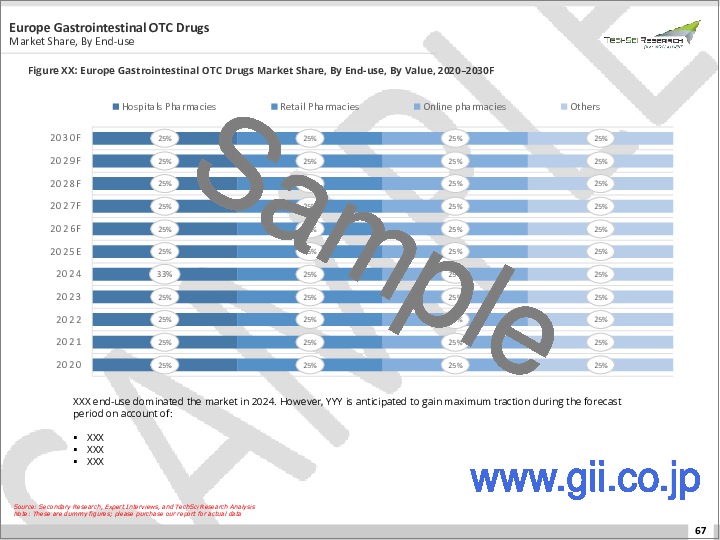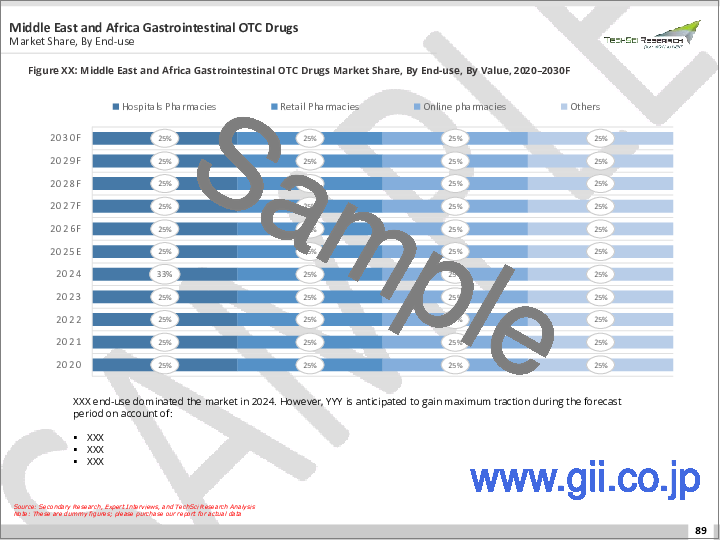|
|
市場調査レポート
商品コード
1668156
消化器OTC医薬品市場- 世界の産業規模、シェア、動向、機会、予測、薬剤クラス別、適応症別、エンドユーザー別、地域別、競合別、2020~2030年Gastrointestinal OTC Drugs Market - Global Industry Size, Share, Trends, Opportunity, and Forecast, Segmented By Drug Class, By Indication, By End User, By Region & Competition, 2020-2030F |
||||||
カスタマイズ可能
|
|||||||
| 消化器OTC医薬品市場- 世界の産業規模、シェア、動向、機会、予測、薬剤クラス別、適応症別、エンドユーザー別、地域別、競合別、2020~2030年 |
|
出版日: 2025年02月28日
発行: TechSci Research
ページ情報: 英文 180 Pages
納期: 2~3営業日
|
- 全表示
- 概要
- 目次
消化器OTC医薬品の世界市場規模は2024年に415億米ドルとなり、2030年までのCAGRは6.15%で、予測期間中に目覚ましい成長が見込まれています。
胃腸薬の大衆薬(OTC)は処方箋なしで入手可能な医薬品であり、一般的な胃腸症状や病状の緩和を目的としています。これらの医薬品は通常、不快感を和らげたり、消化器系の軽微な問題に対処したりするために、消費者が自分で服用するものです。消化器OTC医薬品の主な利点の一つは、入手のしやすさです。消費者は処方箋を必要とせずにこれらの製品を購入することができ、小売薬局、ドラッグストア、スーパーマーケット、オンラインプラットフォームで容易に入手することができます。OTC医薬品は通常、パッケージの指示通り、あるいはヘルスケア専門家の助言に従って使用されます。消化器OTC医薬品は、ラベルに記載された指示に従って使用すれば、安全で効果的であると考えられています。非処方薬であることは、軽度から中等度の胃腸症状がある人のセルフメディケーションに適していることを反映しています。しかし、重度または慢性の胃腸症状のある人は、ヘルスケアプロバイダーの指導を受けるべきです。
| 市場概要 | |
|---|---|
| 予測期間 | 2026-2030 |
| 市場規模:2024年 | 415億米ドル |
| 市場規模:2030年 | 595億1,000万米ドル |
| CAGR:2025年~2030年 | 6.15% |
| 急成長セグメント | 胃酸抑制剤 |
| 最大市場 | 北米 |
世界の高齢化により、胃腸の問題が発生しやすくなっています。高齢化に伴い消化器系の問題が発生しやすくなるため、OTC胃腸薬のニーズが高まっています。胃腸の健康や関連問題に対する消費者の意識が高まるにつれ、一般的な消化器系問題のOTC解決策を求めるようになります。教育キャンペーンや情報普及がこうした意識向上に寄与しています。食生活の乱れ、ストレス、座りっぱなしのライフスタイル、不規則な食事パターンなどの要因が胃腸の問題を引き起こします。こうした生活習慣が、症状を緩和するためのOTC医薬品の需要を押し上げています。OTC医薬品は、一般的な胃腸の問題に対処するための非侵襲的で費用対効果の高い手段を提供します。処方薬や医療処置を検討する前に、OTC医薬品を選択する人も多いです。製薬会社は、消費者の嗜好に応えるため、即効性や持続性のある緩和オプション、チュアブル錠、液体製剤など、OTC胃腸薬の新しい製剤を開発し、技術革新を続けています。
主な市場課題
ジェネリック競合
主要市場動向
自然療法とハーブ療法
目次
第1章 概要
第2章 調査手法
第3章 エグゼクティブサマリー
第4章 顧客の声
第5章 世界の消化器OTC医薬品市場展望
- 市場規模・予測
- 金額別
- 市場シェア・予測
- 薬剤クラス別(下剤、消化器がん治療薬、胃酸抑制剤、下痢止め、プロトンポンプ阻害薬、H2阻害薬、胃酸中和剤、腸内抗炎症薬、制吐剤)
- 適応症別(胃食道逆流症または胸焼け、便秘、下痢、乗り物酔い、その他)
- エンドユーザー別(病院薬局、小売薬局、オンライン薬局、その他)
- 地域別
- 企業別(2024)
- 市場マップ
第6章 アジア太平洋地域の消化器OTC医薬品市場展望
- 市場規模・予測
- 市場シェア・予測
- アジア太平洋地域:国別分析
- 中国
- インド
- オーストラリア
- 日本
- 韓国
第7章 欧州の消化器OTC医薬品市場展望
- 市場規模・予測
- 市場シェア・予測
- 欧州:国別分析
- フランス
- ドイツ
- スペイン
- イタリア
- 英国
第8章 北米の消化器OTC医薬品市場展望
- 市場規模・予測
- 市場シェア・予測
- 北米:国別分析
- 米国
- メキシコ
- カナダ
第9章 南米の消化器OTC医薬品市場展望
- 市場規模・予測
- 市場シェア・予測
- 南米:国別分析
- ブラジル
- アルゼンチン
- コロンビア
第10章 中東・アフリカの消化器OTC医薬品市場展望
- 市場規模・予測
- 市場シェア・予測
- 中東・アフリカ:国別分析
- 南アフリカ
- サウジアラビア
- アラブ首長国連邦
第11章 市場力学
- 促進要因
- 課題
第12章 市場動向と発展
- 最近の動向
- 製品上市
- 合併と買収
第13章 世界の消化器OTC医薬品市場:SWOT分析
第14章 ポーターのファイブフォース分析
- 業界内の競合
- 新規参入の可能性
- サプライヤーの力
- 顧客の力
- 代替品の脅威
第15章 PESTEL分析
第16章 競合情勢
- Viatris Inc.
- Sandoz Group AG
- Johnson & Johnson Services, Inc.
- Sun Pharmaceuticals Industries Limited
- Teva Pharmaceuticals Industries Ltd.
- Zydus Life science Ltd.
- Sanofi SA
- Bayer AG
- Pfizer Inc.
- GlaxoSmithKline Plc
第17章 戦略的提言
第18章 調査会社について・免責事項
Global Gastrointestinal OTC Drugs Market was valued at USD 41.50 Billion in 2024 and is anticipated to witness an impressive growth in the forecast period with a CAGR of 6.15% through 2030. Gastrointestinal over the counter (OTC) drugs are medications that are available without a prescription and are designed to provide relief from a range of common gastrointestinal symptoms and conditions. These drugs are typically self-administered by consumers to alleviate discomfort and manage minor digestive issues. One of the primary advantages of gastrointestinal OTC drugs is their accessibility. Consumers can purchase these products without the need for a prescription, making them readily available at retail pharmacies, drug stores, supermarkets, and online platforms. OTC drugs are typically used as directed on the packaging or as advised by a healthcare professional. Gastrointestinal OTC drugs are considered safe and effective when used according to the labeled instructions. Their non-prescription status reflects their suitability for self-medication by individuals experiencing mild to moderate gastrointestinal symptoms. However, individuals with severe or chronic gastrointestinal conditions should seek guidance from a healthcare provider.
| Market Overview | |
|---|---|
| Forecast Period | 2026-2030 |
| Market Size 2024 | USD 41.50 Billion |
| Market Size 2030 | USD 59.51 Billion |
| CAGR 2025-2030 | 6.15% |
| Fastest Growing Segment | Gastric Acid Reducers |
| Largest Market | North America |
The global aging population is more susceptible to gastrointestinal issues. As people age, they are more likely to experience digestive problems, which increases the need for OTC gastrointestinal remedies. Increasing awareness among consumers about gastrointestinal health and related issues encourages them to seek OTC solutions for common digestive problems. Educational campaigns and information dissemination contribute to this awareness. Factors like poor dietary habits, stress, sedentary lifestyles, and irregular eating patterns contribute to gastrointestinal problems. These lifestyle factors drive the demand for OTC drugs to alleviate symptoms. OTC drugs offer a non-invasive and cost-effective means of managing common gastrointestinal issues. Many individuals prefer OTC options before considering prescription medications or medical procedures. Pharmaceutical companies continue to innovate by developing new formulations of OTC gastrointestinal drugs, such as fast-acting or long-lasting relief options, chewable tablets, and liquid formulations, to cater to consumer preferences.
Key Market Challenges
Generic Competition
Generic gastrointestinal OTC drugs typically cost less than their branded counterparts. This price competition can lead to lower profit margins for pharmaceutical companies that market branded OTC drugs, as consumers often opt for more affordable generic options. Some gastrointestinal OTC drugs have been on the market for a long time, and they may have multiple generic equivalents. This can lead to market saturation, with numerous generic products vying for a share of the market. When a branded OTC drug's patent expires, it opens the door for generic manufacturers to enter the market with their versions of the drug. As a result, the branded drug may experience a decline in market share. The presence of generic competitors can put pressure on branded OTC drug manufacturers to lower their prices, reducing their profitability. They may need to engage in price wars to maintain their market share. Generic drugs are generally perceived as cost-effective alternatives to branded drugs. This perception can lead consumers to switch from branded to generic OTC drugs when available, contributing to the challenges faced by branded manufacturers. Generic drugs must meet regulatory standards for safety, efficacy, and quality, just like branded drugs. Branded manufacturers may face increased scrutiny and competition from generic companies that adhere to these standards. Branded OTC drug manufacturers often invest heavily in marketing and promotional efforts to differentiate their products. However, generic competitors may not invest as much in marketing, relying on price advantage instead. When a branded OTC drug's patent protection or exclusivity period expires, it allows generic manufacturers to introduce their versions. This can lead to a rapid loss of market exclusivity for branded drugs.
Key Market Trends
Natural and Herbal Remedies
Many consumers prefer natural and herbal remedies for gastrointestinal problems because they perceive them as gentler and having fewer side effects compared to synthetic drugs. A growing awareness of holistic health and wellness has encouraged individuals to seek natural and herbal solutions to address the root causes of gastrointestinal issues rather than just managing symptoms. Natural and herbal OTC products often contain plant-based ingredients known for their digestive benefits. Examples include ginger, peppermint, chamomile, aloe vera, and licorice. Probiotic supplements and prebiotic fiber sources have gained popularity for promoting gut health. These products are often considered natural and may be incorporated into OTC gastrointestinal offerings. Homeopathic remedies using highly diluted natural substances are used by some consumers to address digestive discomfort and gastrointestinal conditions. Natural and herbal remedies are often associated with fewer adverse effects, making them appealing to individuals who want to avoid the potential side effects of synthetic medications. Manufacturers have expanded their product lines to include a wide variety of natural and herbal OTC options for different gastrointestinal symptoms, such as herbal teas, dietary supplements, and herbal extracts. Some natural and herbal OTC products combine multiple ingredients to target multiple aspects of gastrointestinal health. For example, a product may include both ginger and fennel to address digestive discomfort and bloating.
Key Market Players
- Viatris Inc.
- Sandoz Group AG
- Johnson & Johnson Services, Inc.
- Sun Pharmaceuticals Industries Limited
- Teva Pharmaceuticals Industries Ltd.
- Zydus Life science Ltd.
- Sanofi SA
- Bayer AG
- Pfizer Inc.
- GlaxoSmithKline Plc.
Report Scope:
In this report, the Global Gastrointestinal OTC Drugs Market has been segmented into the following categories, in addition to the industry trends which have also been detailed below:
Gastrointestinal OTC Drugs Market, By Drug Class:
- Laxatives
- Gastrointestinal Cancer Treatments
- Gastric Acid Reducers
- Anti-Diarrheal
- Proton Pump Inhibitors
- H2 Inhibitors
- Gastric Acid Neutralizers
- Bowel Anti-Inflammatory
- Anti-Emetics
Gastrointestinal OTC Drugs Market, By Indication:
- Gastroesophageal Reflux Disease or Heartburn
- Constipation
- Diarrhea
- Motion Sickness
- Others
Gastrointestinal OTC Drugs Market, By End User:
- Hospitals Pharmacies
- Retail Pharmacies
- Online pharmacies
- Others
Gastrointestinal OTC Drugs Market, By Region:
- North America
- United States
- Canada
- Mexico
- Europe
- France
- United Kingdom
- Italy
- Germany
- Spain
- Asia-Pacific
- China
- India
- Japan
- Australia
- South Korea
- South America
- Brazil
- Argentina
- Colombia
- Middle East & Africa
- South Africa
- Saudi Arabia
- UAE
Competitive Landscape
Company Profiles: Detailed analysis of the major companies present in the Global Gastrointestinal OTC Drugs Market.
Available Customizations:
Global Gastrointestinal OTC Drugs Market report with the given market data, TechSci Research offers customizations according to a company's specific needs. The following customization options are available for the report:
Company Information
- Detailed analysis and profiling of additional market players (up to five).
Table of Contents
1. Product Overview
- 1.1. Market Definition
- 1.2. Scope of the Market
- 1.2.1. Markets Covered
- 1.2.2. Years Considered for Study
- 1.2.3. Key Market Segmentations
2. Research Methodology
- 2.1. Objective of the Study
- 2.2. Baseline Methodology
- 2.3. Key Industry Partners
- 2.4. Major Association and Secondary Sources
- 2.5. Forecasting Methodology
- 2.6. Data Triangulation & Validation
- 2.7. Assumptions and Limitations
3. Executive Summary
- 3.1. Overview of the Market
- 3.2. Overview of Key Market Segmentations
- 3.3. Overview of Key Market Players
- 3.4. Overview of Key Regions/Countries
- 3.5. Overview of Market Drivers, Challenges, Trends
4. Voice of Customer
5. Global Gastrointestinal OTC Drugs Market Outlook
- 5.1. Market Size & Forecast
- 5.1.1. By Value
- 5.2. Market Share & Forecast
- 5.2.1. By Drug Class (Laxatives, Gastrointestinal Cancer Treatments, Gastric Acid Reducers, Anti-Diarrheal, Proton Pump Inhibitors, H2 Inhibitors, Gastric Acid Neutralizers, Bowel Anti-Inflammatory, Anti-Emetics)
- 5.2.2. By Indication (Gastroesophageal Reflux Disease or Heartburn, Constipation, Diarrhea, Motion Sickness, Others)
- 5.2.3. By End User (Hospitals Pharmacies, Retail Pharmacies, Online pharmacies, Others)
- 5.2.4. By Region
- 5.2.5. By Company (2024)
- 5.3. Market Map
6. Asia Pacific Gastrointestinal OTC Drugs Market Outlook
- 6.1. Market Size & Forecast
- 6.1.1. By Value
- 6.2. Market Share & Forecast
- 6.2.1. By Drug Class
- 6.2.2. By Indication
- 6.2.3. By End User
- 6.2.4. By Country
- 6.3. Asia Pacific: Country Analysis
- 6.3.1. China Gastrointestinal OTC Drugs Market Outlook
- 6.3.1.1. Market Size & Forecast
- 6.3.1.1.1. By Value
- 6.3.1.2. Market Share & Forecast
- 6.3.1.2.1. By Drug Class
- 6.3.1.2.2. By Indication
- 6.3.1.2.3. By End User
- 6.3.1.1. Market Size & Forecast
- 6.3.2. India Gastrointestinal OTC Drugs Market Outlook
- 6.3.2.1. Market Size & Forecast
- 6.3.2.1.1. By Value
- 6.3.2.2. Market Share & Forecast
- 6.3.2.2.1. By Drug Class
- 6.3.2.2.2. By Indication
- 6.3.2.2.3. By End User
- 6.3.2.1. Market Size & Forecast
- 6.3.3. Australia Gastrointestinal OTC Drugs Market Outlook
- 6.3.3.1. Market Size & Forecast
- 6.3.3.1.1. By Value
- 6.3.3.2. Market Share & Forecast
- 6.3.3.2.1. By Drug Class
- 6.3.3.2.2. By Indication
- 6.3.3.2.3. By End User
- 6.3.3.1. Market Size & Forecast
- 6.3.4. Japan Gastrointestinal OTC Drugs Market Outlook
- 6.3.4.1. Market Size & Forecast
- 6.3.4.1.1. By Value
- 6.3.4.2. Market Share & Forecast
- 6.3.4.2.1. By Drug Class
- 6.3.4.2.2. By Indication
- 6.3.4.2.3. By End User
- 6.3.4.1. Market Size & Forecast
- 6.3.5. South Korea Gastrointestinal OTC Drugs Market Outlook
- 6.3.5.1. Market Size & Forecast
- 6.3.5.1.1. By Value
- 6.3.5.2. Market Share & Forecast
- 6.3.5.2.1. By Drug Class
- 6.3.5.2.2. By Indication
- 6.3.5.2.3. By End User
- 6.3.5.1. Market Size & Forecast
- 6.3.1. China Gastrointestinal OTC Drugs Market Outlook
7. Europe Gastrointestinal OTC Drugs Market Outlook
- 7.1. Market Size & Forecast
- 7.1.1. By Value
- 7.2. Market Share & Forecast
- 7.2.1. By Drug Class
- 7.2.2. By Indication
- 7.2.3. By End User
- 7.2.4. By Country
- 7.3. Europe: Country Analysis
- 7.3.1. France Gastrointestinal OTC Drugs Market Outlook
- 7.3.1.1. Market Size & Forecast
- 7.3.1.1.1. By Value
- 7.3.1.2. Market Share & Forecast
- 7.3.1.2.1. By Drug Class
- 7.3.1.2.2. By Indication
- 7.3.1.2.3. By End User
- 7.3.1.1. Market Size & Forecast
- 7.3.2. Germany Gastrointestinal OTC Drugs Market Outlook
- 7.3.2.1. Market Size & Forecast
- 7.3.2.1.1. By Value
- 7.3.2.2. Market Share & Forecast
- 7.3.2.2.1. By Drug Class
- 7.3.2.2.2. By Indication
- 7.3.2.2.3. By End User
- 7.3.2.1. Market Size & Forecast
- 7.3.3. Spain Gastrointestinal OTC Drugs Market Outlook
- 7.3.3.1. Market Size & Forecast
- 7.3.3.1.1. By Value
- 7.3.3.2. Market Share & Forecast
- 7.3.3.2.1. By Drug Class
- 7.3.3.2.2. By Indication
- 7.3.3.2.3. By End User
- 7.3.3.1. Market Size & Forecast
- 7.3.4. Italy Gastrointestinal OTC Drugs Market Outlook
- 7.3.4.1. Market Size & Forecast
- 7.3.4.1.1. By Value
- 7.3.4.2. Market Share & Forecast
- 7.3.4.2.1. By Drug Class
- 7.3.4.2.2. By Indication
- 7.3.4.2.3. By End User
- 7.3.4.1. Market Size & Forecast
- 7.3.5. United Kingdom Gastrointestinal OTC Drugs Market Outlook
- 7.3.5.1. Market Size & Forecast
- 7.3.5.1.1. By Value
- 7.3.5.2. Market Share & Forecast
- 7.3.5.2.1. By Drug Class
- 7.3.5.2.2. By Indication
- 7.3.5.2.3. By End User
- 7.3.5.1. Market Size & Forecast
- 7.3.1. France Gastrointestinal OTC Drugs Market Outlook
8. North America Gastrointestinal OTC Drugs Market Outlook
- 8.1. Market Size & Forecast
- 8.1.1. By Value
- 8.2. Market Share & Forecast
- 8.2.1. By Drug Class
- 8.2.2. By Indication
- 8.2.3. By End User
- 8.2.4. By Country
- 8.3. North America: Country Analysis
- 8.3.1. United States Gastrointestinal OTC Drugs Market Outlook
- 8.3.1.1. Market Size & Forecast
- 8.3.1.1.1. By Value
- 8.3.1.2. Market Share & Forecast
- 8.3.1.2.1. By Drug Class
- 8.3.1.2.2. By Indication
- 8.3.1.2.3. By End User
- 8.3.1.1. Market Size & Forecast
- 8.3.2. Mexico Gastrointestinal OTC Drugs Market Outlook
- 8.3.2.1. Market Size & Forecast
- 8.3.2.1.1. By Value
- 8.3.2.2. Market Share & Forecast
- 8.3.2.2.1. By Drug Class
- 8.3.2.2.2. By Indication
- 8.3.2.2.3. By End User
- 8.3.2.1. Market Size & Forecast
- 8.3.3. Canada Gastrointestinal OTC Drugs Market Outlook
- 8.3.3.1. Market Size & Forecast
- 8.3.3.1.1. By Value
- 8.3.3.2. Market Share & Forecast
- 8.3.3.2.1. By Drug Class
- 8.3.3.2.2. By Indication
- 8.3.3.2.3. By End User
- 8.3.3.1. Market Size & Forecast
- 8.3.1. United States Gastrointestinal OTC Drugs Market Outlook
9. South America Gastrointestinal OTC Drugs Market Outlook
- 9.1. Market Size & Forecast
- 9.1.1. By Value
- 9.2. Market Share & Forecast
- 9.2.1. By Drug Class
- 9.2.2. By Indication
- 9.2.3. By End User
- 9.2.4. By Country
- 9.3. South America: Country Analysis
- 9.3.1. Brazil Gastrointestinal OTC Drugs Market Outlook
- 9.3.1.1. Market Size & Forecast
- 9.3.1.1.1. By Value
- 9.3.1.2. Market Share & Forecast
- 9.3.1.2.1. By Drug Class
- 9.3.1.2.2. By Indication
- 9.3.1.2.3. By End User
- 9.3.1.1. Market Size & Forecast
- 9.3.2. Argentina Gastrointestinal OTC Drugs Market Outlook
- 9.3.2.1. Market Size & Forecast
- 9.3.2.1.1. By Value
- 9.3.2.2. Market Share & Forecast
- 9.3.2.2.1. By Drug Class
- 9.3.2.2.2. By Indication
- 9.3.2.2.3. By End User
- 9.3.2.1. Market Size & Forecast
- 9.3.3. Colombia Gastrointestinal OTC Drugs Market Outlook
- 9.3.3.1. Market Size & Forecast
- 9.3.3.1.1. By Value
- 9.3.3.2. Market Share & Forecast
- 9.3.3.2.1. By Drug Class
- 9.3.3.2.2. By Indication
- 9.3.3.2.3. By End User
- 9.3.3.1. Market Size & Forecast
- 9.3.1. Brazil Gastrointestinal OTC Drugs Market Outlook
10. Middle East and Africa Gastrointestinal OTC Drugs Market Outlook
- 10.1. Market Size & Forecast
- 10.1.1. By Value
- 10.2. Market Share & Forecast
- 10.2.1. By Drug Class
- 10.2.2. By Indication
- 10.2.3. By End User
- 10.2.4. By Country
- 10.3. MEA: Country Analysis
- 10.3.1. South Africa Gastrointestinal OTC Drugs Market Outlook
- 10.3.1.1. Market Size & Forecast
- 10.3.1.1.1. By Value
- 10.3.1.2. Market Share & Forecast
- 10.3.1.2.1. By Drug Class
- 10.3.1.2.2. By Indication
- 10.3.1.2.3. By End User
- 10.3.1.1. Market Size & Forecast
- 10.3.2. Saudi Arabia Gastrointestinal OTC Drugs Market Outlook
- 10.3.2.1. Market Size & Forecast
- 10.3.2.1.1. By Value
- 10.3.2.2. Market Share & Forecast
- 10.3.2.2.1. By Drug Class
- 10.3.2.2.2. By Indication
- 10.3.2.2.3. By End User
- 10.3.2.1. Market Size & Forecast
- 10.3.3. UAE Gastrointestinal OTC Drugs Market Outlook
- 10.3.3.1. Market Size & Forecast
- 10.3.3.1.1. By Value
- 10.3.3.2. Market Share & Forecast
- 10.3.3.2.1. By Drug Class
- 10.3.3.2.2. By Indication
- 10.3.3.2.3. By End User
- 10.3.3.1. Market Size & Forecast
- 10.3.1. South Africa Gastrointestinal OTC Drugs Market Outlook
11. Market Dynamics
- 11.1. Drivers
- 11.2. Challenges
12. Market Trends & Developments
- 12.1. Recent Developments
- 12.2. Product Launches
- 12.3. Mergers & Acquisitions
13. Global Gastrointestinal OTC Drugs Market: SWOT Analysis
14. Porter's Five Forces Analysis
- 14.1. Competition in the Industry
- 14.2. Potential of New Entrants
- 14.3. Power of Suppliers
- 14.4. Power of Customers
- 14.5. Threat of Substitute Product
15. PESTLE Analysis
16. Competitive Landscape
- 16.1. Viatris Inc.
- 16.1.1. Business Overview
- 16.1.2. Product & Service Offerings
- 16.1.3. Recent Developments
- 16.1.4. Financials (If Listed)
- 16.1.5. Key Personnel
- 16.1.6. SWOT Analysis
- 16.2. Sandoz Group AG
- 16.3. Johnson & Johnson Services, Inc.
- 16.4. Sun Pharmaceuticals Industries Limited
- 16.5. Teva Pharmaceuticals Industries Ltd.
- 16.6. Zydus Life science Ltd.
- 16.7. Sanofi SA
- 16.8. Bayer AG
- 16.9. Pfizer Inc.
- 16.10.GlaxoSmithKline Plc






